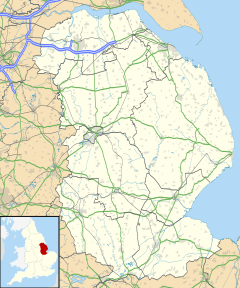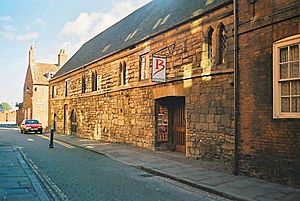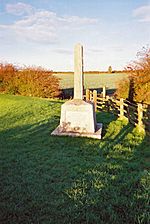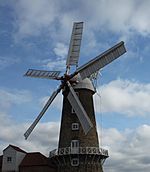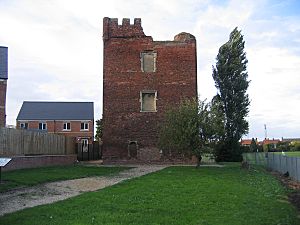Boston, Lincolnshire facts for kids
Quick facts for kids Boston |
|
|---|---|
| Market town | |
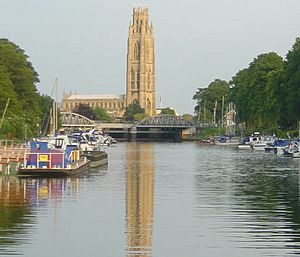 St Botolph's Church viewed from the river |
|
| Area | 18.42 km2 (7.11 sq mi) |
| Population | 45,339 (2021 Census.Ward) |
| • Density | 2,461/km2 (6,370/sq mi) |
| OS grid reference | TF329437 |
| • London | 100 mi (160 km) S |
| District |
|
| Shire county | |
| Region | |
| Country | England |
| Sovereign state | United Kingdom |
| Post town | BOSTON |
| Postcode district | PE21 |
| Dialling code | 01205 |
| Police | Lincolnshire |
| Fire | Lincolnshire |
| Ambulance | East Midlands |
| EU Parliament | East Midlands |
| UK Parliament |
|
Boston is a lively market town and inland port located in Lincolnshire, England. It's the main town in the Boston area.
In 2021, about 45,339 people lived in Boston. The wider borough had around 66,900 residents in 2015.
Boston's most famous landmark is St Botolph's Church, often called 'The Stump'. It's the largest parish church in England and you can see it from miles away! People from Boston are known as Bostonians. Many places around the world, especially in the United States, were named after Boston by people who moved from here. The most famous is Boston, Massachusetts.
Contents
What's in a Name?
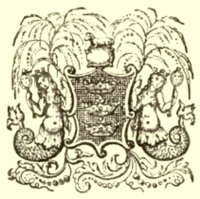
The name Boston likely comes from "Saint Botolph's town." Saint Botolph was an important monk. The name Botulfeston was used in 1460, which also meant "St. Botulf's village."
Boston's Story: A Look Back
Early Days
People once thought Boston was a Roman settlement, but there's no proof of this. It was also linked to a monastery built by the Saxon monk Botolph in AD 654. This monastery was destroyed by Vikings in 870. However, historians now doubt it was in Boston. Botolph was a popular saint, and many churches are named after him.
The Domesday Book from 1086 doesn't mention Boston by name. But it does talk about nearby areas like Skirbeck, which is now part of Boston. Skirbeck had two churches, and one was probably dedicated to St Botolph. This suggests Boston was growing around that church.
Boston grew because it was a good place where a navigable river met land routes. This made it perfect for trade.
Growing as a Port
After the Normans took over England, Boston became a very important town and port. By the early 1200s, Boston was a major trading hub with Europe. It was even part of the Hanseatic League, a group of trading cities. In the 13th century, it was said to be the second busiest port in England!
King Edward III made Boston a special port for the wool trade in 1369. Besides wool, Boston also exported salt (made nearby), grain, and lead from other parts of England.
However, trade started to decline around 1470. The local guilds (groups of merchants) became less powerful. Also, more wool was being woven into cloth in England, reducing the need to export raw wool. The river also started to get blocked with silt, making it harder for ships to reach the port.
When King Henry VIII closed down monasteries in England, Boston's friaries (religious houses) were taken over. One of these, the Dominican friary, was later turned into the Blackfriars Arts Centre in 1965.
Boston received its own special charter from Henry VIII in 1545. From 1552, Boston had two Members of Parliament, who represented the town in government.
17th and 18th Centuries
Boston was a place where many people had different religious ideas. In 1607, a group of Pilgrims from another part of England tried to leave the country from Boston. They wanted more religious freedom in the Netherlands. But leaving without permission was against the law. They were caught and brought to the Guildhall. Most were released and later sailed to the Netherlands. In 1620, some of these Pilgrims sailed to America on the Mayflower and helped start New England.
Boston remained a place of strong religious beliefs. John Cotton, a vicar at St Botolph's, encouraged people to join the Massachusetts Bay Colony in America. He even helped name the city of Boston, Massachusetts. He eventually moved there himself in 1633.
Around this time, people started draining the fens (wetlands) around Boston. This made some people unhappy because it affected their way of life, like hunting birds. This, along with religious disagreements, led Boston to support the Parliament in the English Civil War (which started in 1642).
Boston saw a revival in the late 1700s when the fens were finally drained well. This made the land very fertile. Boston began exporting grain to London. The first bank opened in 1774, and in 1776, streetlights were put up.
Modern Times
In the 1800s, companies in Boston like Howden and Tuxford became famous for making steam engines and farming machines.
The railway arrived in Boston in 1848. For a short time, Boston was on the main railway line from London to the north. Boston remained an important railway hub, moving farm products and goods from the port. It also took people on trips to Skegness.
Boston became a major port for trade and fishing again in 1884 when a new dock was built. It still exports grain and recycled materials, and imports timber and steel.
During the First World War, some of Boston's fishermen were captured by German ships. The town was also bombed by a Zeppelin in 1916, sadly killing a child.
The first cinema opened in 1910. A new town bridge was built in 1913. Central Park, bought in 1919, is now a popular spot. Electricity came to Boston early in the century, and street lighting was installed in 1924.
During the Second World War, 17 local people died in air raids. There's a memorial for them in Boston Cemetery.
The Haven Bridge, which carries two main roads over the river, opened in 1966. A new dual carriageway, John Adams Way, was built in 1976–78 to help traffic flow better. A shopping centre, the Pescod Centre, opened in 2004, bringing new shops to town.
Healthcare
Boston Cottage Hospital opened in 1871. It was rebuilt in the 1960s and is now called the Pilgrim Hospital. Princess Anne officially opened it in 1977. The hospital is currently building a new, larger Emergency Department.
Getting Around
Trains
Boston railway station is on the Poacher Line. East Midlands Railway runs trains about once an hour between Nottingham, Grantham, and Skegness.
The railways came to Boston in 1848. For a short time, Boston was home to the main locomotive (train engine) workshops for the Great Northern Railway. These workshops later moved to Doncaster.
Buses
Bus services in Boston are mainly run by Stagecoach East, Stagecoach East Midlands, and Brylaine Travel. Buses connect Boston to nearby towns like Lincoln, Skegness, and Spalding.
People of Boston
According to the 2021 Census, Boston's population is about 70,500. This is a 9.1% increase from 2011, which is higher than the national average for England. A lot of this growth is due to people moving to Boston from other countries, especially from Eastern Europe. For example, 5.6% of Boston's population was born in Lithuania and 5.4% in Poland. Polish is also the main language for 5.68% of the people living here.
Fun Things to See and Do
Boston has always had strong links to the Netherlands, and you can see Dutch style in its buildings.
Famous Places
The parish church of Saint Botolph is known as Boston Stump. It's famous for its huge size and how it stands out in the flat countryside.
The Great Sluice is hidden by bridges. It helps keep the tide out of the fens and lets river water clean out the Haven twice a day.
Near the Stump, Bostonians used to have their jail. This is probably where the Scrooby Pilgrims were held in 1607.
There's a statue of Herbert Ingram in front of the Stump. He founded The Illustrated London News, a famous newspaper. He also helped bring piped water and railways to Boston.
The seven-story Maud Foster Windmill was finished in 1819. It was fully restored in the late 1980s and works again today. It's special because it has five sails, which is an odd number for a windmill!
The Guildhall, where the Pilgrim Fathers were tried, became a museum in 1929. You can see the cells where the Pilgrims were supposedly kept. It reopened in 2008 after a big renovation.
The Pilgrim Fathers Memorial is a few miles outside town, on the north bank of The Haven. This is where the Pilgrims first tried to leave for the Dutch Republic in 1607.
The ruined Hussey Tower is what's left of a medieval brick house built in 1450. Another medieval tower house, Rochford Tower, is about 2 miles east.
The Prime Meridian line passes through the eastern side of Boston. You can find a street called Meridian Road that sits right on this line.
The annual Boston May Fair has been held in the town since at least 1125. It's one of the few fairs still held in the town centre. The mayor traditionally opens it on May 3rd.
Blackfriars is a theatre and arts centre. It used to be the dining hall of a friary built in the 13th century. Even King Edward I visited it once!
Frampton Marsh and Freiston Shore are two nature reserves managed by the RSPB. They are great places to see birds and wildlife on The Wash coast.
The Boston Preservation Trust has a Blue Plaque Trail. These plaques mark important historical places in the town. As of 2024, there are 27 plaques.
Local Business
Boston's most important businesses are:
- Food production: Growing vegetables and potatoes.
- Transport: Companies that move food and other goods by road.
- Port of Boston: Handles over a million tons of cargo each year. It imports steel and timber, and exports grain and recycled materials. The port is connected by rail and major roads.
- Fishing: Catching shellfish.
- Other light industries** and **tourism.
Boston's market is held every Wednesday and Saturday in one of England's largest marketplaces. There's also an extra market and auction on Wednesdays.
The town has many local and national shops. Pescod Square shopping centre has stores like Next and HMV. Other big names include New Look, Sports Direct, and TK Maxx. You'll also find several supermarkets like Tesco, Asda, Aldi, and Lidl. In 2021, a new department store called Rebos opened in the town centre.
A big development called The Quadrant was announced in 2013. It's being built on the edge of town. The first part includes a new football ground for Boston United F.C., new homes, shops, and businesses. It also starts a new road to connect the A52 and A16. The second part might include another marina and more homes and shops.
Sports in Boston
Rugby
The Princess Royal Arena is home to Boston Rugby Football Club. The club started in 1927.
Football
Boston has two non-league football clubs. The main team, Boston United, is nicknamed the Pilgrims. They play in the National League. They moved to their new Jakeman's stadium on the edge of town for the 2020–21 season. The town's second club, Boston Town, is nicknamed the Poachers. They play at their stadium on Tattershall Road.
Rowing
Boston Rowing Club hosts the annual Boston Rowing Marathon every September. Crews from all over the world compete in this 33-mile (53 km) race, starting in Lincoln and finishing in Boston.
Speedway
Speedway racing used to happen in Boston in the 1970s and 1980s. The Boston Barracudas team even won the League and Knock-out Cup in 1973!
Swimming
Boston Amateur Swimming Club holds swimming events and training at the Geoff Moulder Swimming Pool.
Sailing
Witham Sailing Club is located on the banks of the River Witham.
News and Radio
Boston has two weekly newspapers: the Boston Standard and the Boston Target.
The town also has a community radio station called Endeavour FM.
Schools and Colleges
Secondary Schools
- Boston Grammar School: An all-boys school for students who pass an entrance exam.
- Boston High School: An all-girls school for students who pass an entrance exam.
- Both grammar schools have sixth forms (for older students) that are open to both boys and girls.
- Haven High Academy: Has two campuses. It was formed in 1992 from the merger of two other schools.
Colleges
Boston College is a college for further education. It opened in 1964 and offers A-level courses and other vocational training. It has three sites in the town.
Independent Schools
St George's Preparatory School is the only independent school in Boston. It opened in 2011 and is for children aged 3–11.
Famous People from Boston
Many interesting people have come from Boston! Here are a few:
Public Service
- John Foxe (1516/17–1587): A famous historian who wrote about martyrs.
- George Bass (1771–1803): A naval surgeon and explorer of Australia.
- Arthur Callender (1875–1936): An engineer and archaeologist who helped Howard Carter explore Tutankhamun's tomb.
- Janet Lane-Claypon, Lady Forber (1877–1967): A doctor and scientist who studied diseases.
- Sir Jonathan Van-Tam (born 1964): A top medical officer for England during the COVID-19 pandemic.
Arts and Writing
- John Taverner (c1490–1545): A well-known composer and organist.
- Jean Ingelow (1820–1897): A poet and novelist.
- Elizabeth Jennings (1926–2001): A respected poet.
- Brian Bolland (born 1951): A famous comics artist who worked for DC Comics.
- Robert Webb (born 1972): A popular comedian, actor, and writer, known for "Mitchell and Webb."
- Courtney Bowman (born 1995): A talented stage actress and singer.
Sport
- Melanie Marshall (born 1982): An Olympic swimmer who now coaches other Olympic winners.
- Hannah Macleod (born 1984): An Olympic Gold Medal-winning field hockey player.
- Crista Cullen (born 1985): Another Olympic Gold Medal-winning English field hockey player.
- Emma Bristow (born 1990): A motorcycle trials rider and current Women's World Champion.
- Ollie Chessum (born 2000): A rugby player.
Boston's Sister Cities
Boston is part of the new Hanseatic League, which promotes trade, culture, and education. Boston also has several twin towns:
- Boston, Massachusetts, United States
- Laval, France; Boston's link with Laval is one of the oldest twin town connections in the world.
- Hakusan, Japan
Weather in Boston
| Climate data for Holbeach No.2, (1991–2020 normals, extremes 1991–present) | |||||||||||||
|---|---|---|---|---|---|---|---|---|---|---|---|---|---|
| Month | Jan | Feb | Mar | Apr | May | Jun | Jul | Aug | Sep | Oct | Nov | Dec | Year |
| Record high °C (°F) | 14.9 (58.8) |
17.7 (63.9) |
22.7 (72.9) |
25.9 (78.6) |
28.0 (82.4) |
31.0 (87.8) |
29.1 (84.4) |
34.1 (93.4) |
29.3 (84.7) |
28.9 (84.0) |
18.0 (64.4) |
15.6 (60.1) |
34.1 (93.4) |
| Mean daily maximum °C (°F) | 7.3 (45.1) |
8.1 (46.6) |
10.6 (51.1) |
13.4 (56.1) |
16.4 (61.5) |
19.3 (66.7) |
21.7 (71.1) |
21.8 (71.2) |
18.9 (66.0) |
14.9 (58.8) |
10.4 (50.7) |
7.6 (45.7) |
14.2 (57.6) |
| Daily mean °C (°F) | 4.6 (40.3) |
4.9 (40.8) |
6.8 (44.2) |
9.1 (48.4) |
12.1 (53.8) |
14.9 (58.8) |
17.1 (62.8) |
17.1 (62.8) |
14.6 (58.3) |
11.4 (52.5) |
7.4 (45.3) |
4.9 (40.8) |
10.4 (50.7) |
| Mean daily minimum °C (°F) | 1.8 (35.2) |
1.7 (35.1) |
3.0 (37.4) |
4.8 (40.6) |
7.7 (45.9) |
10.4 (50.7) |
12.4 (54.3) |
12.3 (54.1) |
10.3 (50.5) |
7.8 (46.0) |
4.3 (39.7) |
2.1 (35.8) |
6.6 (43.9) |
| Record low °C (°F) | −7.1 (19.2) |
−15.6 (3.9) |
−6.0 (21.2) |
−4.5 (23.9) |
−2.3 (27.9) |
1.3 (34.3) |
2.4 (36.3) |
4.8 (40.6) |
0.7 (33.3) |
−3.6 (25.5) |
−7.6 (18.3) |
−9.9 (14.2) |
−15.6 (3.9) |
| Average precipitation mm (inches) | 50.8 (2.00) |
38.5 (1.52) |
36.0 (1.42) |
42.5 (1.67) |
50.7 (2.00) |
57.9 (2.28) |
57.7 (2.27) |
64.2 (2.53) |
52.6 (2.07) |
63.3 (2.49) |
56.5 (2.22) |
52.5 (2.07) |
623.1 (24.53) |
| Average precipitation days (≥ 1.0 mm) | 11.0 | 9.6 | 8.4 | 8.6 | 9.0 | 9.1 | 9.6 | 9.8 | 8.5 | 10.8 | 11.6 | 11.0 | 116.9 |
| Source 1: Met Office | |||||||||||||
| Source 2: Starlings Roost Weather | |||||||||||||
Places Near Boston
 |
Lincoln, Tattershall, Dogdyke, Langrick, Brothertoft, Sheffield | Horncastle, Louth, Midville, Stickney, Carrington, Sibsey, Frithville, Cleethorpes, Grimsby, Doncaster, Hull | Skegness, Wainfleet, Friskney, Wrangle, Leverton, Benington, |  |
| North Forty Foot Bank, Hubberts Bridge, Heckington, Sleaford, Leicester, Nottingham | Freiston, Butterwick, | |||
| Swineshead, Bicker, Donington, Bourne | Wyberton, Frampton, Kirton, Spalding, London | Fishtoft, Freiston Shore, Fenside |
See also
 In Spanish: Boston (Lincolnshire) para niños
In Spanish: Boston (Lincolnshire) para niños


